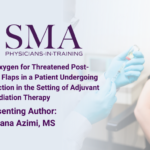Abstract | May 6, 2021
Hyperbaric Oxygen for Threatened Post-Mastectomy Skin Flaps in a Patient Undergoing Breast Reconstruction in the Setting of Adjuvant Radiation Therapy
Learning Objectives
- Adjuvant radiation therapy in the setting of post-mastectomy breast reconstruction can pose significant challenges to successful reconstruction, including ischemic changes to the overlying skin flap, potentially threatening the underlying tissue expander or implant.
- Hyperbaric oxygen should be considered as a salvage therapy in patients who have undergone radiation therapy during breast reconstruction and are presenting with features of tissue injury.
Introduction:
This is a case of a patient who underwent radiation therapy after the first stage of post-mastectomy breast reconstruction using Wise pattern approach, posing ischemic threat to one of her skin flaps and the underlying tissue expander. Hyperbaric oxygen was considered as a potential therapy to restore skin flap viability.
Case Presentation:
A 59-year-old woman with type 2 diabetes mellitus, hypertension, obesity, and stage IIB triple-negative invasive ductal carcinoma of the right breast presented for bilateral mastectomy and reconstruction with implantation of bilateral tissue expanders (Allergan 750 mL) with acellular dermal matrix slings (AlloDerm). Preoperatively, the patient underwent neoadjuvant chemotherapy, receiving doxorubicin and cyclophosphamide followed by paclitaxel and carboplatin. Two weeks post-surgery, the patient’s incisions were healing well without signs of infection.
In the ensuing months, both breasts were complicated by wound dehiscence at the triple point. The right breast was managed with a single debridement with application of silver nitrate and bacitracin. The left breast was managed in the same fashion initially but ultimately required hospital admission for further debridement of the wound bed due to necrotic tissue and purulent drainage. Nearly ten months after the initial reconstruction, the patient returned with severe changes to the right breast mastectomy flap as a result of radiation treatment. At this visit, there was concern for mastectomy flap failure and tissue expander threat in light of apparent severe radiation dermatitis, erythema, superficial skin breakdown,
and associated cellulitis. The patient was immediately referred for hyperbaric oxygen therapy at an external facility with a 10-day course of doxycycline. The patient returned two months later with resolved radiation dermatitis and the decision was made to proceed with bilateral second-stage breast reconstruction with replacement of tissue expanders to permanent implants.
Working Diagnosis:
The most likely diagnosis in this patient is radiation-induced dermatitis of the right breast with apparent skin necrosis and possible underlying necrotic involvement of the tissue expander.
Management/Outcome:
The right breast was successfully salvaged with hyperbaric oxygen therapy, allowing for subsequent second-stage reconstruction with replacement of tissue expanders with bilateral silicone implants.

